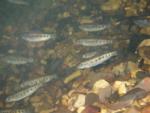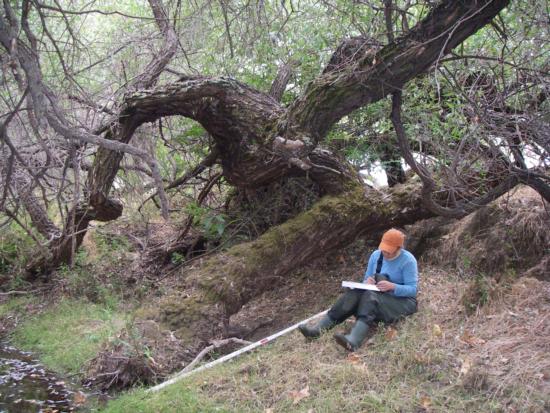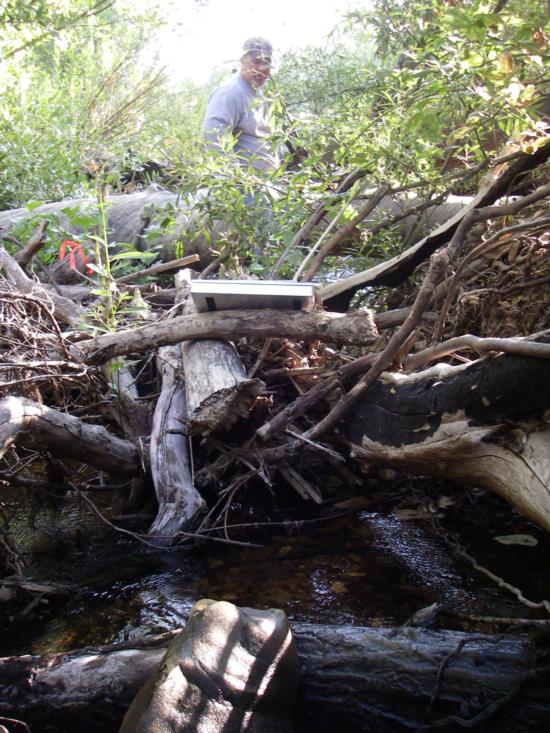Steelhead Distribution and Habitat Use in the Salinas River Watershed
-
IssueThe Salinas River and its tributaries have been designated by the National Marine Fisheries Service as critical habitat for steelhead (Oncorhynchus mykiss), listed as “threatened” under the Federal Endangered Species Act. The watershed is part of the South-Central California Coast Evolutionarily Significant Unit (ESU) for steelhead. Large wood is known to be very important to fish habitat in conifer-dominated streams of the Pacific Northwest, but has not been well studied in hardwood-dominated streams of the central California coast.

-
Objectives
Large wood plays a key role in the creation and maintenance of fish habitat in small coastal streams in the Pacific Northwest. Large wood, defined as pieces of wood with length =1 m, and diameter =10 cm, influences channel geomorphology by stabilizing channels, and trapping gravel that fish use for spawning. Large wood is also used as habitat by macroinvertebrates, important food for fish. Pools often form under logs that have fallen into a stream, or immediately upstream of wood jams.
Information on fish habitat and steelhead abundance is scarce for the California central coast and prior to this study, virtually non-existent for the upper Salinas River. We conducted this study to provide an estimate of large wood loading in the watershed for comparison with other published accounts of large wood loading for streams dominated by coniferous or hardwood riparian forests. We surveyed the fish community to determine the distribution and density of steelhead and other native fish species as well as to determine the occurrence of non-native fish species. Finally, we examined the role of hardwood large wood in forming pools.
-
Research Activities
In July and August 2006 we studied the occurrence and function of hardwood large wood in relation to stream habitat and threatened steelhead distribution in the hardwood-dominated Upper Salinas River watershed in central-coastal California. We sampled fifteen sites located on four tributaries and on the main stem of the Salinas River. At each site, we measured the volume of fallen dead large wood (logs, root wads), standing trees, and not-standing live wood (exposed roots, living fallen trees) within the bankfull width. Fish density and length were estimated by a snorkel survey.
-
Results
Willow (Salix spp.), oak (Quercus spp.), California sycamore (Platanus racemosa), and Fremont cottonwood (Populus fremontii) dominated the sites. Fallen dead large wood volume within the bankfull width averaged 47.6 m3/ha (SD =58.2) across all sites. Total large wood volume, including fallen dead, not-standing live wood, and standing live and dead trees averaged 222.0 m3/ha (SD = 173.7). Fallen dead large wood volumes on the central coast were almost sixteen times less than conifer-dominated sites in the Pacific Northwest, but similar to volumes on private hardwood-dominated north coast sites. At thirteen sites at least half the pools were formed due to large wood, or experienced some influence of large wood. An average of 4.01 fish/meter (SD = 3.08) were observed at fourteen sites. Steelhead were observed at nine sites, averaging 0.23 fish/meter across fourteen sites (SD = 0.35).
-
Outcomes and Impacts
Hardwood large wood appears to be an important component of steelhead habitat in central-coastal California streams, due to its influence on pool formation. It may be possible for private landowners in the upper Salinas River watershed to increase the volume of dead fallen hardwood LW in streams on their properties through the use of best management practices (BMPs) as suggested in Opperman et al. (2006). Such practices have not yet been determined or tested for this region, but would likely include activities to: (1) promote the regeneration of hardwood riparian trees such as oaks, California sycamore, Fremont cottonwood, and willows; (2) promote the survival of hardwood seedlings; (3) allow trees to reach a size at which their diameter would be sufficient to allow them to function as large wood; and (4) leave fallen dead large wood in the channel to contribute to fish habitat such as pools. The development of BMPs for large wood would thus be a valuable step in riparian management and steelhead recovery, given the broad distribution of fish in the watershed, the concerns of landowners over fish-related regulations, and the role of hardwood large wood in contributing to pool habitat. The adoption of voluntary BMPs should increase the capacity of private landowners, resource agency staff, and public interest groups to cooperate in the management of fish-bearing streams on hardwood-dominated lands. Our results have been presented to stakeholders in the Salinas River watershed, at numerous fisheries conferences, and in several reports and peer-review articles.
-
Photos
 Jenna Voss takes field notes near a large willow beside a Salinas River tributary. Photo by Lisa Thompson.
Jenna Voss takes field notes near a large willow beside a Salinas River tributary. Photo by Lisa Thompson. Ryan Cooper measures wood in a wood jam on a Salinas River tributary stream. Photo by Lisa Thompson.
Ryan Cooper measures wood in a wood jam on a Salinas River tributary stream. Photo by Lisa Thompson. -
Supporting Information
Thompson, Lisa C., Jenna L. Voss, Royce E. Larsen, William D. Tietje, Ryan A. Cooper, and Peter B. Moyle. 2012. Southern Steelhead, Hard Woody Debris, and Temperature in a California Central Coast Watershed. Transactions of the American Fisheries Society, 141:2, 275-284. Download
Thompson, L.C., J.L. Voss, R.E. Larsen, W.D. Tietje, R.A. Cooper, and P.B. Moyle. 2008. Role of hardwood in forming habitat for southern California steelhead. pp. 307-319 in Merenlender, Adina; McCreary, Douglas; Purcell, Kathryn L. (tech. eds) Proceedings of the sixth California oak symposium: today's challenges, tomorrow's opportunities. Gen. Tech. Rep. PSW-GTR-217. Albany, CA: U.S. Department of Agriculture, Forest Service, Pacific Southwest Research Station. 677 p. Download
Voss, Jenna L., Lisa C. Thompson, Royce E. Larsen, William D. Tietje, Ryan A. Cooper, and Peter B. Moyle. 2007. Cooperator report: Habitat requirements of steelhead in the upper Salinas River watershed. San Luis Obispo County Publication, 14 p. Download
Boughton, D. A., P. B. Adams, E. Anderson, C. Fusaro, E. A. Keller, E. Kelley, L. Lentsch, J. Nielsen, K. Perry, H. Regan, J. J. Smith, C. Swift, L. Thompson, and F. Watson. 2007. Viability criteria for steelhead of the south-central and southern California coast. U.S. Dep. Commer., NOAA Tech. Memo. NOAA-TM-NMFS-SWFSC-XXX, 33 p. Request Reprint
Boughton, D. A., P. B. Adams, E. Anderson, C. Fusaro, E. A. Keller, E. Kelley, L. Lentsch, J. Nielsen, K. Perry, H. Regan, J. J. Smith, C. Swift, L. Thompson, and F. Watson. 2006. Steelhead of the south-central/southern California coast: Population characterization for recovery planning. U.S. Dep. Commer., NOAA Tech. Memo. NMFS-SWFSC-394, 123 p. Download Note: File size is 23 MB
-
Acknowledgements
This project was funded by a grant from the Renewable Resources Extension Act.
-
For more information contact
Dr. Lisa C. Thompson
Wildlife, Fish, & Conservation Biology Department
University of California, DavisEmail: lcthompson@ucdavis.edu
Phone: (530) 754-5732



